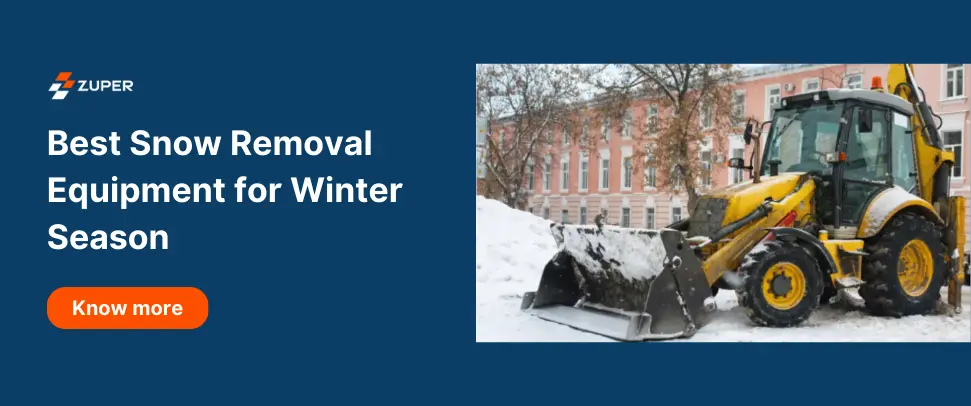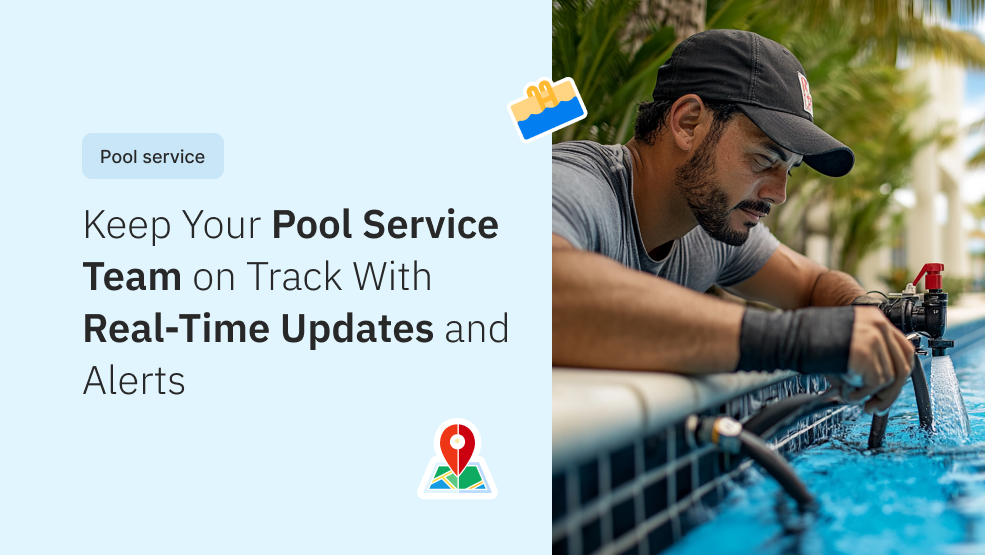Snow plowing experiences high demand during the winter months, placing significant pressure on fleet managers. Are you in charge of a fleet and frustrated about unplanned breakdowns resulting in a chaotic scramble to find solutions? What if we told you that the key to mastering winter’s challenges lines in a single word: maintenance?
By periodically performing a thorough inspection of your plowing equipment, you no longer have to worry about last-minute failures and the stressful work of devising an emergency reallocation plan. Read along to learn about the tips and tricks that will make your job more predictable. At the end of the article, we have an equipment maintenance checklist; make sure to download it and keep it handy for the winter season.
Pre-season maintenance is the key to peak performance
The secret to snow plow maintenance lies in doing pre-season inspections. Pre-season inspections are critical to keeping your equipment ready to go when winter rolls around. Follow the checklist given below to help make sure your business runs smoothly during your busiest times of the year.
1. Change the hydraulic fluid
Hydraulic systems are the backbone of snow plows, controlling their movement and functionality. Changing hydraulic fluid before the season ensures the system operates smoothly, avoiding potential leaks and malfunctions. Old or contaminated fluid can lead to decreased performance and even damage to the system components.
2. Grease the vertical pin and wear points
Snow plows rely on various moving parts to function, including the vertical pin in v-plows and other wear points. Applying grease reduces friction and wear, extending the lifespan of these crucial components. It ensures smooth movement and minimizes the risk of parts seizing or breaking during operation.
3. Clean, inspect, and grease electrical connections
Corroded or damaged electrical connections can lead to electrical failures in snow plow equipment. Cleaning and greasing these connections prevent corrosion and ensure reliable electrical functions, such as activating lights, hydraulics, and other controls.
4. Check nuts and bolts
Snow plow equipment is subjected to substantial vibrations and stresses during use. Regularly checking and tightening nuts and bolts prevents parts from coming loose while plowing, which can lead to operational issues and potential safety hazards.
5. Check plow cylinders, hoses, and pump
Hydraulic system leaks can compromise plow performance and lead to costly repairs. Regularly inspecting plow cylinders, hoses, and pumps for leaks and addressing any issues promptly prevents hydraulic fluid loss and maintains optimal plow functionality.
6. Tighten trip and return springs
Trip and return springs control the movement of the plow blade, allowing it to adapt to various terrains and obstacles. Proper tension ensures that the plow can effectively trip and return to its position, improving snow-clearing efficiency and reducing strain on the equipment.
7. Inspect the plow cutting edge
The cutting edge of a plow blade is essential for efficient snow removal. Inspecting it for wear and replacing it when necessary ensures that the plow can effectively cut through snow and ice, minimizing the strain on the equipment and the operator.
8. Replace plow shoes
Plow shoes prevent the plow blade from scraping and damaging the pavement underneath. Replacing worn plow shoes prevents excessive wear on both the plow and the surfaces being cleared, extending the life of the equipment and reducing maintenance costs.
9. Inspect and replace snow removal equipment fluids
Snow removal equipment, including snow plow trucks, require various fluids, such as engine oil, transmission fluid, hydraulic fluid, and coolant, to operate effectively in cold conditions. Checking and replacing these fluids ensures the truck’s engine and components function optimally, enhancing overall performance and longevity.
10. Test the truck’s battery
Cold weather can be tough on batteries. Ensuring the truck’s battery is in good condition and fully charged is crucial for reliable starts and consistent operation, especially during freezing temperatures.
11. Get a mechanical inspection
A professional mechanical inspection helps identify potential issues that may not be apparent during routine checks. This comprehensive evaluation ensures that the entire snow plow setup, including the truck and plow equipment, is in top condition before the season begins.
12. Tighten all fasteners
Ensuring all fasteners are properly tightened reduces the risk of components coming loose during operation. This step enhances safety, prevents equipment damage, and maintains efficient snow-clearing performance.
Winter maintenance keeps operations smooth & efficient
1. Regular inspections
Regularly inspecting the plowing equipment during the season helps detect wear and tear early. This proactive approach allows for timely repairs, reducing the likelihood of equipment breakdowns and ensuring consistent snow removal performance.
2. Check fluid level
Monitoring and maintaining proper fluid levels, including hydraulic fluid and engine oil, prevent equipment malfunctions and optimize performance. Low fluid levels can lead to inefficiencies and potential damage to components.
3. Inspect electrical connections
Continuously checking for corrosion or damage in electrical connections prevents unexpected electrical failures that could impact plow functionality, lighting, and other essential features.
4. Grease moving parts
Ongoing greasing of moving parts reduces friction, prevents wear, and ensures smooth operation. Well-lubricated components experience less stress and are less likely to malfunction.
5. Clean after each use
Thoroughly cleaning the plowing equipment after each use removes salt, sand, dirt, and debris. This not only maintains the equipment’s appearance but also prevents corrosion and damage, ultimately extending its lifespan.
Post-season maintenance prepares for next winter
1. Inspect for damage
After a season of heavy use— a comprehensive inspection helps identify any wear and tear, impact damage, or potential issues that may have arisen during operation.
2. Repair as needed
Addressing identified damage and issues promptly prevents further deterioration and ensures that the equipment is fully operational when needed next season. Delaying repairs can lead to more extensive and costly problems.
3. Clean and store
Cleaning the plowing equipment thoroughly removes any accumulated grime and prevents corrosion during storage. Storing the equipment in a dry, secure place protects it from the elements, such as rain and snow, which can cause rust and other forms of damage.
Tips to tackle winter maintenance
The pro tip we would suggest to any snow plow business is to keep a record of equipment maintenance and repair. This may sound like a lot of extra work. But, trust us, it will be a win-win situation for you and your team. Besides, you will save a lot of time and money by avoiding unexpected breakdowns and expensive repairs.
1. No expensive surprises
Imagine catching a small problem before it becomes a major headache. By checking your equipment’s condition regularly and fixing any issues early on, you can prevent expensive repairs down the road. For instance, if you notice the hydraulic fluid is running low, you can replace it promptly in order to make sure your system is not damaged.
2. A legal shield
Say you end up in a sticky situation where someone’s pointing fingers at you. Having a record of all maintenance performed can save the day. It shows you have been responsible and taken care of your equipment, which can really help your case. For example, if someone slips on unshoveled snow and tries to blame you, you can prove you have been working to keep it cleared on a regular basis.
3. Fast problem-solving
When equipment in your fleet suffers a failure, having a history of its maintenance and repairs is like giving your mechanic a cheat code. With thorough documentation on what work has previously been done, they track down the problem quicker, getting you up and running in no time. So, if you know your plow’s been leaking hydraulic fluid, your mechanic can jump straight to fixing that instead of playing detective.
4. Smart planning
By keeping a record of when your equipment has received maintenance, you can be better prepared in planning future work. It is no different from knowing when your car needs an oil change—having a record of previous maintenance allows you to budget and schedule in advance so you are not caught off guard.
5. Appealing to insurance companies
Some insurance companies want to see proof that you are taking good care of your equipment. It is like showing them you are not just winging it. Having a solid record of maintenance and repairs makes you more appealing to insurers, leading to better rates and coverage.

Take the next step
Start doing pre-season maintenance and stop worrying about equipment failures during the winter season. Increase your fleet productivity and prevent expensive repairs by following the maintenance tips we have discussed. If you want to further enhance the process of equipment maintenance, purchase a field service management software product and simplify maintenance and repair record keeping.
Excited to experience Zuper firsthand? Begin your 14-day free trial today.








